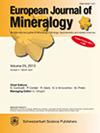Some thoughts about eclogites and related rocks
IF 1.7
3区 地球科学
Q2 MINERALOGY
引用次数: 1
Abstract
Abstract. The past 40 years have been a golden age for eclogite studies, supported by an ever wider range of instrumentation and enhanced computational capabilities, linked with ongoing developments in thermobarometry and geochronology. During this time, we have made robust estimates of pressure–temperature (P–T) conditions; determined ages related to the prograde, metamorphic peak and retrograde stages; and calculated time-integrated rates of cooling and exhumation for eclogites and related rocks, including blueschists, from orogenic belts worldwide. Improvements to single mineral thermometers and new developments in elastic barometry using inclusions of one mineral in another (e.g. quartz and/or zircon in garnet), coupled with ongoing innovations in petrochronology and diffusion modelling, presage a new age for eclogite studies in which detailed quantification of metamorphic conditions and timescales will be linked to an improved understanding of processes at all scales. Since the turn of the century, numerical modelling of subduction zone and rock exhumation processes has become increasingly important. As a result, subduction and exhumation are quite well understood, but the volume of continental crust subducted to and returned from mantle conditions and the amount lost to the mantle are largely unknown. We have generated sufficient data to investigate the spatiotemporal distribution of metamorphism and secular change but not without controversy in relation to the rare occurrence of orogenic eclogites and the absence of blueschists prior to the late Neoproterozoic and the emergence of plate tectonics on Earth. Since the turn of the century, the assumption that metamorphic pressure is lithostatic has come under increasing scrutiny. Whether local variations in stress extrapolate to the crustal scale and, if so, whether the magnitude of the calculated deviations from lithostatic pressure can be generated and sustained in mechanically heterogeneous rock units remains contentious. Could the paradigm of subduction of continental lithosphere to mantle depths be simply an artefact of the lithostatic assumption? Fluid cycling in subduction zones and understanding the role of fluids in the generation of intermediate-depth earthquakes remain important topics of current research. Dry (H2O-absent) conditions are unlikely around the peak of ultrahigh-pressure (UHP) metamorphism or during exhumation, due to dehydroxylation of nominally anhydrous minerals and breakdown of hydrous minerals at P–T conditions in the realm of supercritical fluid and hydrous melt. Indeed, the presence of melt may be necessary to facilitate the exhumation of HP and UHP tectonometamorphic rock units. Finally, our ability to interrogate inclusions in superdeep diamonds should lead to a better understanding of how the deep interior and surface are linked in the context of Earth as a fully coupled system.关于榴辉岩及相关岩石的几点思考
摘要过去的40年是生态学研究的黄金时代,这得益于越来越广泛的仪器和不断增强的计算能力,以及热气压计和地质年代学的不断发展。在此期间,我们对压力-温度(P-T)条件进行了稳健估计;确定了与前进期、变质峰期和逆行期有关的年龄;并计算了世界各地造山带榴辉岩和相关岩石(包括蓝片岩)的冷却和挖掘的时间积分速率。单矿物温度计的改进和使用一种矿物包裹体(例如石榴石中的石英和/或锆石)的弹性气压计的新发展,加上岩石年代学和扩散模型的不断创新,预示着榴辉岩研究的新时代,在这个时代,变质条件和时间尺度的详细量化将与对所有尺度过程的更好理解联系在一起。自世纪之交以来,俯冲带和岩石掘出过程的数值模拟变得越来越重要。因此,我们对俯冲和挖掘已经有了很好的了解,但是大陆地壳俯冲到地幔并从地幔中返回的体积,以及消失到地幔中的数量在很大程度上是未知的。我们已经获得了足够的数据来研究变质作用的时空分布和长期变化,但尽管关于造山榴辉岩的罕见出现和晚新元古代之前蓝片岩的缺失以及地球上板块构造的出现存在争议。自世纪之交以来,变质压力是静态岩石的假设受到越来越多的审查。应力的局部变化是否可以外推到地壳尺度,如果可以,计算出的与静岩压力的偏差的大小是否可以在力学非均质岩石单元中产生和维持,这些问题仍然存在争议。大陆岩石圈向地幔深处俯冲的范式是否仅仅是岩石静力学假设的产物?俯冲带的流体循环和流体在中深地震发生中的作用仍然是当前研究的重要课题。在超高压(UHP)变质峰附近或在挖掘过程中,由于名义上无水矿物的脱羟基作用以及超临界流体和含水熔体领域P-T条件下含水矿物的分解,干燥(无水)条件不太可能出现。事实上,熔体的存在可能有助于挖掘出高压和超高压构造变质岩单元。最后,我们研究超深钻石内含物的能力应该能让我们更好地理解,在地球作为一个完全耦合的系统的背景下,深部内部和表面是如何联系在一起的。
本文章由计算机程序翻译,如有差异,请以英文原文为准。
求助全文
约1分钟内获得全文
求助全文
来源期刊
CiteScore
2.80
自引率
9.50%
发文量
40
审稿时长
6-12 weeks
期刊介绍:
EJM was founded to reach a large audience on an international scale and also for achieving closer cooperation of European countries in the publication of scientific results. The founding societies have set themselves the task of publishing a journal of the highest standard open to all scientists performing mineralogical research in the widest sense of the term, all over the world. Contributions will therefore be published primarily in English.
EJM publishes original papers, review articles and letters dealing with the mineralogical sciences s.l., primarily mineralogy, petrology, geochemistry, crystallography and ore deposits, but also biomineralogy, environmental, applied and technical mineralogy. Nevertheless, papers in any related field, including cultural heritage, will be considered.

 求助内容:
求助内容: 应助结果提醒方式:
应助结果提醒方式:


